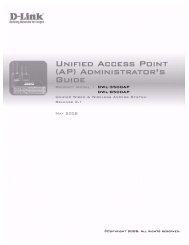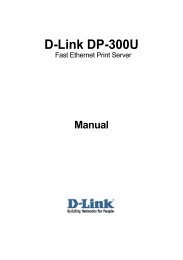Product Manual
Product Manual
Product Manual
Create successful ePaper yourself
Turn your PDF publications into a flip-book with our unique Google optimized e-Paper software.
Click Apply to implement changes made.<br />
SNMP Manager<br />
SNMP Settings<br />
DES-3526 / DES-3526DC Fast Ethernet Layer 2 Switch<br />
conjunction with the Host Based choice in the Auth. Mode field.<br />
NOTE: To set the SSH User Authentication parameters on the Switch, a<br />
User Account must be previously configured. For more information on<br />
configuring local User Accounts on the Switch, see the User Accounts<br />
section of this manual located in this section.<br />
Simple Network Management Protocol (SNMP) is an OSI Layer 7 (Application Layer) designed<br />
specifically for managing and monitoring network devices. SNMP enables network management<br />
stations to read and modify the settings of gateways, routers, switches, and other network devices.<br />
Use SNMP to configure system features for proper operation, monitor performance and detect<br />
potential problems in the Switch, switch group or network.<br />
Managed devices that support SNMP include software (referred to as an agent), which runs locally on<br />
the device. A defined set of variables (managed objects) is maintained by the SNMP agent and used to<br />
manage the device. These objects are defined in a Management Information Base (MIB), which<br />
provides a standard presentation of the information controlled by the on-board SNMP agent. SNMP<br />
defines both the format of the MIB specifications and the protocol used to access this information over<br />
the network.<br />
The DES-3526 supports the SNMP versions 1, 2c, and 3. You can specify which version of the SNMP<br />
you want to use to monitor and control the Switch. The three versions of SNMP vary in the level of<br />
security provided between the management station and the network device.<br />
In SNMP v.1 and v.2, user authentication is accomplished using 'community strings', which function<br />
like passwords. The remote user SNMP application and the Switch SNMP must use the same<br />
community string. SNMP packets from any station that has not been authenticated are ignored<br />
(dropped).<br />
The default community strings for the Switch used for SNMP v.1 and v.2 management access are:<br />
• public - Allows authorized management stations to retrieve MIB objects.<br />
• private - Allows authorized management stations to retrieve and modify MIB objects.<br />
SNMPv3 uses a more sophisticated authentication process that is separated into two parts. The first<br />
part is to maintain a list of users and their attributes that are allowed to act as SNMP managers. The<br />
second part describes what each user on that list can do as an SNMP manager.<br />
The Switch allows groups of users to be listed and configured with a shared set of privileges. The<br />
SNMP version may also be set for a listed group of SNMP managers. Thus, you may create a group of<br />
SNMP managers that are allowed to view read-only information or receive traps using SNMPv1 while<br />
assigning a higher level of security to another group, granting read/write privileges using SNMPv3.<br />
Using SNMPv3 individual users or groups of SNMP managers can be allowed to perform or be<br />
restricted from performing specific SNMP management functions. The functions allowed or restricted<br />
are defined using the Object Identifier (OID) associated with a specific MIB. An additional layer of<br />
security is available for SNMPv3 in that SNMP messages may be encrypted. To read more about how<br />
to configure SNMPv3 settings for the Switch read the next section.<br />
141

















